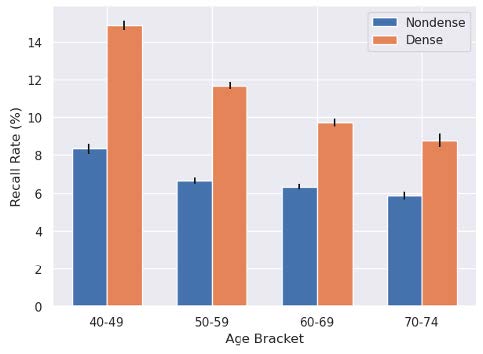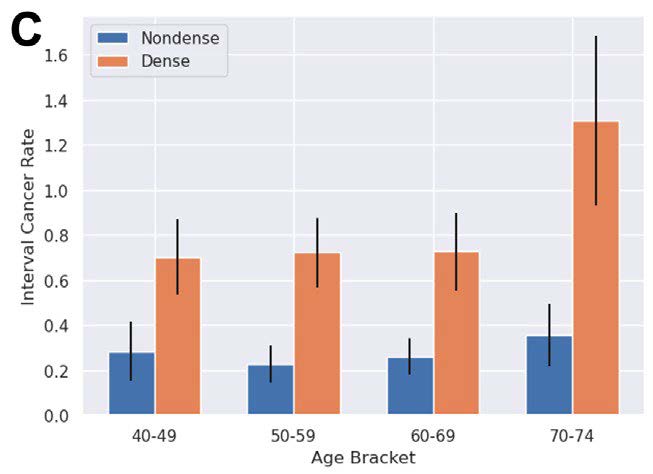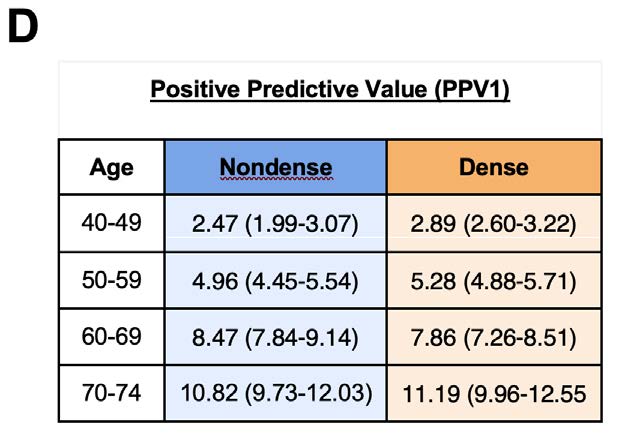Conference Presentation
Screen-Detected and Interval Breast Cancer Rates Are Significantly Higher in Women with Dense Breasts Across All Age Groups in a Large DBT Dataset
RSNA 2022
Melina Tsitsiklis, MD, Leeann Louis, Jiye G. Kim, Bryan Haslam, A. Gregory Sorensen
November 28, 2022
Purpose
High breast density is associated with both increased breast cancer risk and decreased sensitivity of screening mammography, contributing to higher overall breast cancer rates and interval breast cancer rates. The Breast Cancer Surveillance Consortium (BCSC) previously showed that interval cancer rates are higher in women with dense breasts undergoing screening with full-field digital mammography, but little data is available for digital breast tomosynthesis (DBT). We sought to compare cancer rates by breast density on women undergoing screening with DBT using a dataset comparable to BCSC.
Materials and Methods
Retrospective data was collected including one DBT screening mammogram from each of 559,791 women undergoing screening between 2017-2021 at over 200 clinical locations, excluding first screens, and with at least one year of follow-up. Screen-detected cancer rate and interval cancer rate were calculated per 1000 women. Analyses are separated by women with nondense (fatty or scattered fibroglandular) and dense (heterogeneously dense or very dense) breast tissue, following BI-RADS 5th Edition guidelines.
Results
Across all age groups, women with dense breasts had a 1.8x higher recall rate, 1.4x higher CDR, and 2.9x higher interval cancer rate compared to women with nondense breasts. CDR is higher in women with dense breasts in all age brackets (dense/nondense CDR: age 40-49: 2.0; 50-59: 1.8; 60-69: 1.4; 70-74: 1.4, p < 0.001 for all differences). Interval cancer rate was higher in women with dense breasts in all age brackets (dense/nondense interval cancer rate: age 40-49: 2.5; 50-59: 3.2; 60-69: 2.8; 70-74: 3.7, p<0.01 for all differences). While the positive predictive value of recalls (PPV1) was similar for women with dense breasts compared to nondense breasts in age groups above 50, women ages 40-49 with dense breasts who were recalled were more likely to have cancer detected than women with nondense breasts (dense/nondense PPV1: 1.17).
Conclusion
In a group of more than half a million women, women with dense breasts undergoing screening mammography with DBT show increased rates of cancer detection and interval cancer rates compared to women without dense breasts, across all age groups. Women aged 40-49 with dense breasts had a higher recall rate but also a higher likelihood of a cancer diagnosis than women without dense breasts. Mammographic breast density, even with DBT, remains associated with higher rates of cancer.
Clinical Relevance
Mammographic breast density is a strong risk factor for breast cancer and for interval breast cancers, even when DBT is used. Our results suggest women aged 40-49 with dense breasts particularly benefit from screening mammography.
A 
B 


Figure 1.
A. Cancer detection rate (per 1,000 screens); B. Recall rate (%); C. Interval cancer rate (per 1,000 screens); D. Positive predictive value of recalls (%) in nondense (fatty or scattered fibroglandular) vs. dense (heterogeneously dense or very dense) breasts of women across ages. Numbers in parentheses indicate 95% confidence intervals as calculated with the Adjusted Wald method.